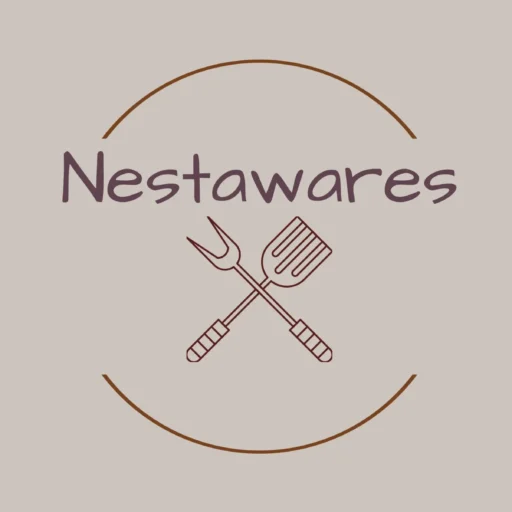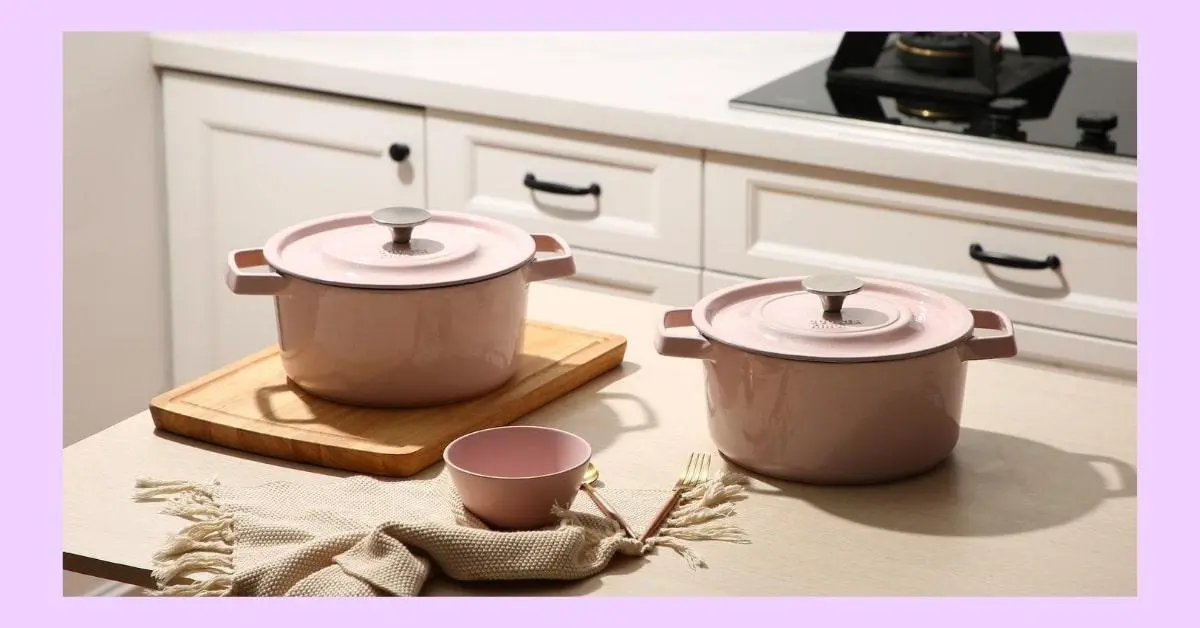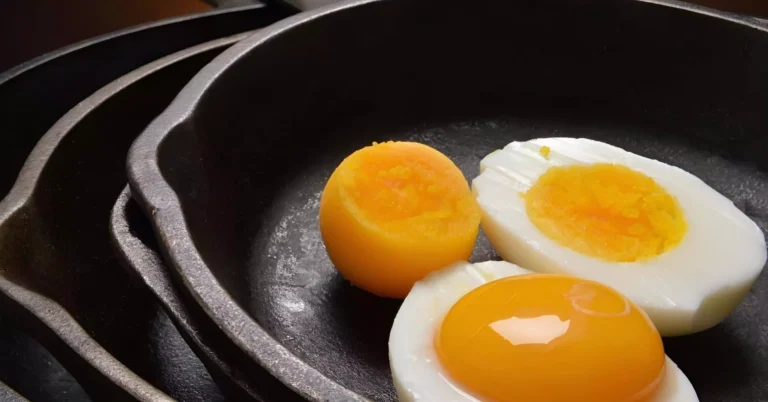For over 200 years, Dutch ovens have formed an integral part of almost every culinary culture. Variations of the famed Dutch oven have also existed much before that. English ironmaster Abraham Darby, is to be attributed for originally coming up with the design and construction of this kitchen essential.
Dutch ovens are perfect for a variety of recipes ranging from sauces to a classic roast chicken. It is probably one of the most used kitchen utensil during holiday season, and especially during Thanksgiving.
Extremely useful during family gatherings and small parties, you won’t fail to impress your guests with the dishes that only a Dutch oven can help you make.
In this post, I have tried to answer most of your queries as to why you need one in your kitchen, and how you should use it. I hope this helps you in making a more informed purchase decision.
Table of Contents
What is a Dutch Oven?

A Dutch Oven is a heavy cooking pot with thick walls and a tight fitting lid. They are usually constructed from cast iron which is what makes them heavier than their peers.
Dutch ovens are generally used for slow cooking over long hours and are perfect for making dishes like stews, roasts, casseroles and even for braising.
They can be used to start on stovetops before moving into the oven.
Their heavy build allows for use during camping, or barbecue parties with coals around the pot and even in high-temperature ovens. They can be very versatile and durable pieces of cookware.
They can withstand rough use over the years and yet provide optimal performance in the kitchen. And outdoors.
As mentioned previously, they are generally made from cast iron. The majority of the models available also have an enamel coating over the bakeware to make it easier to clean. Seasoning isn’t required before use, with these models.
However, the ones made from pure cast iron would need to be seasoned well to form a patina, before we can proceed with cooking.
The lids are tight-fitting to aid in keeping the moisture and heat sealed inside the pot. They have heat-resistant knobs to help with safe handling of the lids. They also have sturdy heat-resistant handles for easy lifting and transfer of food.
How It Works
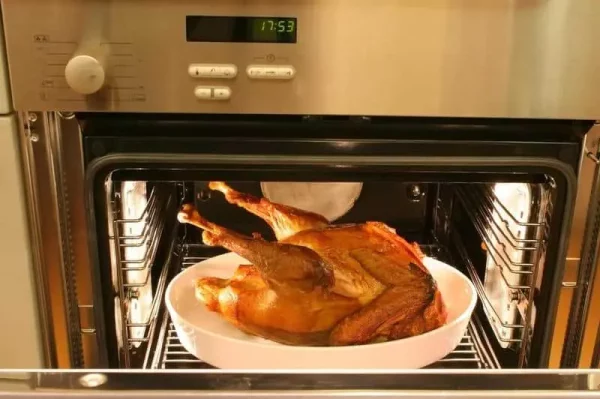
A Dutch oven is quite the kitchen powerhouse. Most models are oven-compatible and can work with stovetops as well.
What makes it so versatile is its heavy construction that allows home chefs to prepare many diverse dishes. It is great for browning, baking, frying, braising and stewing. There’s only a few other culinary tools that are quite as multifaceted as this one.
A Dutch oven is a large pot with thick walls and is usually built with very strong cast iron. The build helps in maintaining even heat distribution. It can retain heat quite well too.
It has a heavy bottom with a tight fitting lid, that adequately seals your food as it cooks. The multi-use pot can easily be transitioned from stovetop to the oven in case you want your roast chicken to cook well in even heat before moving to a pan for a clean sear.
Sautéing veggies, baking lasagna and brewing all kinds of stew is a breeze with this one. You can bake bread with it, as well as experiment with other dishes so as long you learn how to be flexible with it.
What to Look For
Size
Dutch Ovens come in various sizes, but I would say that the ones with 5-6 quarts of capacity hit the sweet spot. Most recipes that make use of Dutch Ovens are often designed for bakeware of this capacity.
A whole roast chicken, or recipes that involve feeding a small gathering of close friends is perfect for a Dutch this size.
Large batches of soups and sauces, and proteins that weigh about 10lb require sizes of 8-10 quarts. Whereas if you are feeding only a family of say, 4 – a Dutch oven ranging between 3-5 quarts would work.
Build Material
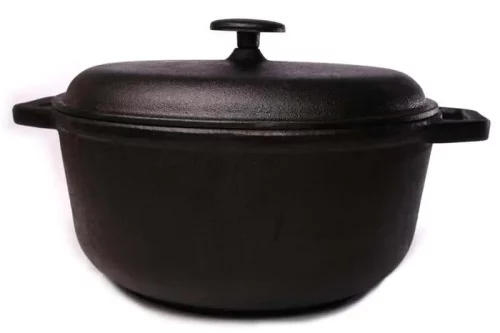
- Cast Iron. Longer heat retention and doubles as a slow cooker in many cases. Definitely the most preferable material for Dutch ovens to made from.
They can be quite heavy but the heat distribution is excellent and the material can last for ages. They would need some seasoning first before you can use it, but not much else is required to take care of these aside from the cleaning requirements.
They can be reactive to acidic food, but the ones that are coated with enamel do not have that problem. - Enamelled Cast Iron. This is basically a subset of the above but the enamel coating fixes all the problems that non-enameled ones have. Food doesn’t burn or stick to the surface.
There is no need for pre-seasoning in order to cook with it. And there are no special cleaning requirements. The weight is about the same as a bare cast iron oven, and has the same first-rate heat retention.
The enamel also allows buyers to pick from different color options. You will expect some peeling over the years, but the utensil remains the same in terms of performance.
However, the only downside is the popular ones come with a hefty price tag. While there are models out there that do not cost as much, it would still be an investment either way. - Ceramic.These give the lightest build out of all of the above. Additionally, cleaning isn’t too hard and they are compatible with both the oven and stove cooktops. This makes them ideal for baking bread and braising meat.
They may be oven-safe but often the knobs on the lids cannot go above 400 degrees. So you need to be cautious when handling the bakeware.
And since ceramic is basically stone, you will also have to be careful not to drop or bang them too hard otherwise they tend to crack. Or worse still, shatter. - Stainless Steel. While they provide a lighter alternative to cast iron Dutch ovens, stainless steel is generally not preferable since they do not retain heat as well as cast iron does.
Not only that, they do not come with lids that fit well which is integral to cooking Dutch Oven recipes perfectly.
But maintenance is a breeze, with no special requirements for cleaning and storage. They are corrosion resistant and non-reactive too.
What can you cook with it?
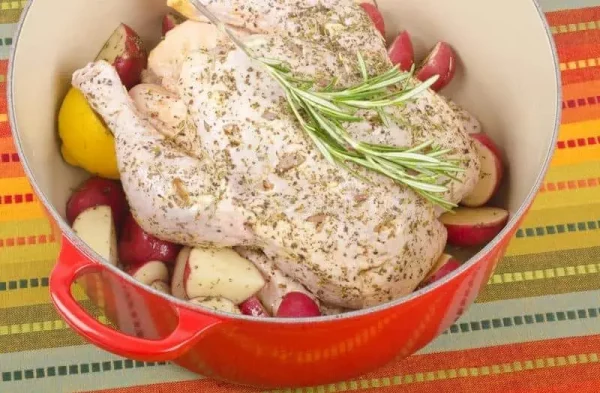
Tough cuts of meat are always perfect for cooking in a Dutch oven. These turn out to be the most succulent and flavorful pieces when cooked long and slow in a Dutch oven.
Pork shoulders and beef briskets for starters, while you can explore other recipes like a good old creamy mac and cheese. Or a hearty hot pot, with braised meat and baked veggies. And maybe bake some bread or crispy doughnuts for dessert.
You should be careful with acidic foods that include citrus as they may react with the build. And anything that sticks to the surface like eggs or flaky fish should be cooked after a thorough seasoning session with your cast iron.
Best Brands to Pick From
Le Creuset and Staub for the highest quality French-made enamelled cast iron Dutch Oven.
Here are a few alternatives to Le Creuset, if you want something cheaper and lighter.
Lodge if you prefer bare cast iron instead.
There are affordable options in the market sold by Cuisinart, Great Jones, Misen and Denby too, if spending more than $300 on a pot isn’t something you have in mind.
